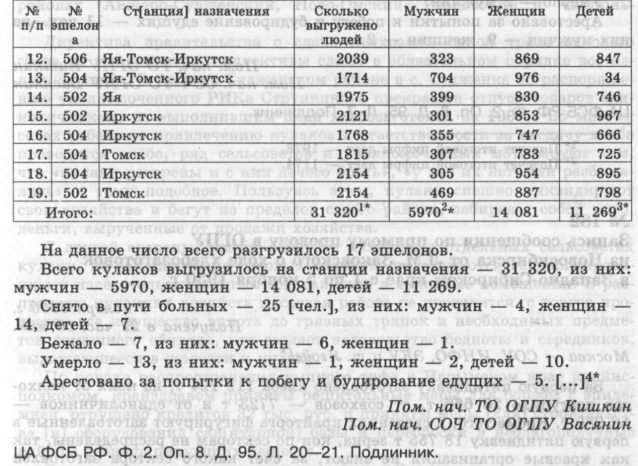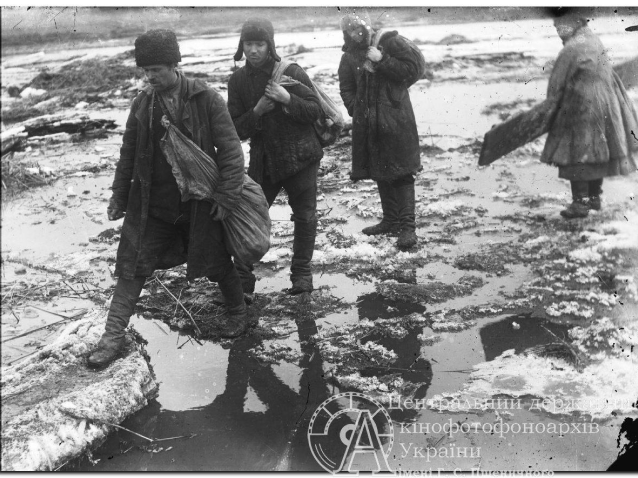Encyclopedia
Deportations of Ukrainians in the 1930s. The policy of dekulakization
The Soviet Union’s rule over occupied Ukraine was marked by forced deportation and persecution from the start until its dissolution. In the early 1920s, the first wave of deportations targeted the Ukrainian intelligentsia. Following that, the Stalinist regime forcibly deported about 131,409 peasant Ukrainians to the Urals during the 1930s–a time marked by the invention of Polaroid and Nazism, the rise of swing and blues music, and a period of mass deportations and genocide against the Ukrainian people.
Despite the Soviet government’s claim to be anti-imperialist, it methodically employed colonial practices, particularly it exploited the occupied lands for economic gain. Moscow, the USSR’s metropolis, aimed to conquer Ukraine, a predominantly agricultural country in the early twentieth century, and turn it into a resource-rich appendage. Ukraine’s favorable geography, fertile soil, and expertise in agriculture made it highly valuable to the Soviet Union. However, Ukrainian farmers, who often owned private lands on an entrepreneurial scale, were the greatest barrier to the establishment of communist rule in Ukraine.
The Soviet government’s efforts to establish a socialist regime in all villages, including collectivization and forced nationalization of land, were met with resistance. The Ukrainian peasantry’s refusal to comply frequently resulted in forced eviction to the far east of Russia, leading to mass deportations in the 1930s.
These escalated deportation measures were preceded by failed attempts at mass collectivization, the elimination of individual farms and the creation of collective farms. This involved the forced socialization of land, equipment, and working and productive livestock; the elimination of private and cooperative sectors; the introduction of socialist management forms; and the establishment of state ownership over agriculture means. The Bolshevik government resorted to these drastic measures to address the grain problem and the grain procurement crisis that had emerged due to early Soviet agricultural policies in 1917-1927.
The shift in land and food policy was officially established in the resolutions of the Central Committee of the CPSU (b) «On the Pace of Collectivization and Measures of State Assistance to Collective Farm Construction» on January 5, 1930, and «On the Pace of Further Collectivization and Tasks to Strengthen Collective Farms» on August 2, 1931. The ultimate goal was to include at least 68–70% of peasant households in collective farms, encompassing 75–80% of their cultivated land [1]. Wealthy peasants largely resisted this policy, opposing the forced incorporation of their farms and lands into Soviet collective farms. This ignited a violent conflict between the government and wealthy peasants, an ontological clash between two different cultures that played out in economic, political, and everyday life. The Soviet government, driven by imperialist ambitions, sought to control Ukraine’s occupied territories and align the peasants with its vague Marxist concept of technically advanced proletarian on the land,” “educated” and “socialist” [2, 140].

Materials of the commission of the Politburo of the Central Committee of the CPSU (B) chaired by the People’s Commissar of Agriculture of the USSR Yakovlev on the preparation of a draft resolution of the Central Committee of the CPSU (B) on the pace of collectivization and measures of state assistance to collective farm construction. From Minutes No. 112 of the meeting of the Politburo of the Central Committee of the CPSU on the collectivization plan and measures of state assistance to collective farm construction. January 5, 1930 [3, 84].
The pressure from the Soviet government to relinquish property to collective farms only fueled the peasant resistance movement. In 1929, 244,000 peasants participated in 1307 mass demonstrations against grain procurement and the establishment of collective farms. By March 1930, the ODPU recorded 6528 protests, with some escalating into armed uprisings; another 176 mass protests, according to the ODPU, were of an insurgent nature, i.e., farmers demanded the overthrow of the Soviet government. In some areas, these protests evolved into full-fledged peasant wars, leading to the dispersal of communist authorities in certain district centers and villages, such as Shepetivka, Volyn, Berdychiv, and Korosten districts, where 282 village councils ceased to function. In March 1930, in Tulchyn, Vinnytsia, and Mohyliv-Podilskyi districts, peasant unrest covered the territory of 343 village councils, with Soviet power being liquidated in 73 villages, and the ODPU recorded 81 armed protests [2, 142].
These incidents were detailed in the reports by the head of the GPU of the Ukrainian SSR, V. Balytsky, sent daily to Stalin. Balytsky personally traveled by armored train, with cavalry groups, to quell the rebellious villagers. Archival documents include a message No. 54389 from March 9, 1930, detailing protests in 16 districts in Ukraine, including Berdychiv, Sumy, Proskuriv, Dnipro, Izyum, Tulchyn, Volyn, Bila Tserkva, Kremenchuk, Poltava, and others. In one case, 40 peasants from Labun (the Polonyansky district in the Shepetivka region), armed with hunting rifles and axes, marched to the district center of Hrytsiv, joined by another 400 peasants. During these uprisings, Soviet activists suffered 386 casualties [4]. A subsequent report, dated March 16, 1930, documented uprisings across 153 villages in the Tulchyn district, where the Soviet government was expelled from 60 villages, local elders were elected, and collective farms were dissolved. These actions reflected the typical demands of Ukrainian peasants: the dissolution of collective farms, removal of communist activists, return of confiscated property, and a distinct patriotic sentiment, with farmers even singing Ukrainian anthem at protests [5].

These episodes prompted the Soviet leadership to seek ways to “solve the problem” of the wealthy, pro-Ukrainian peasantry, reffered to as “kulaks” in official documents. Following a colonial approach, the Moscow-based USSR government chose punitive methods to quash resistance, including forced confiscation of property from wealthy peasants and their subsequent deportation to Russia’s interior. To identify “kulaks” and “kulak farms”, Soviet authorities used a resolution of the USSR Council of People’s Commissars from May 21, 1929, that classified a peasant farm as a kulak farm if it met at least one of the following criteria:
- systematic use of hired labor for agricultural work or in cottage industries and enterprises within the limits that, according to the legislation on the election of Soviets, do not deprive the owner of voting rights;
- ownership of a mill, gristmill, vegetable dryer or any other industrial tool, provided that it uses a mechanical engine or a water mill or windmill with two or more posts;
- permanent lease of complex agricultural machinery with mechanical engines;
- lease of separately equipped premises for housing or business for a season or for a long time;
- engaging in trade, usury, commercial intermediation or any other non-labor income [6, 116].
DON’T MISS IT
Subscribe for our news and update
In the fall of 1930, district departments of the GPU of the Ukrainian SSR began mass evictions of those resisting collectivization and dekulakization to remote USSR regions. To ensure the implementation of preparatory measures for the deportation, a coordinating body was created in the districts. It consisted of the secretary of the RPK, the head of the REC, and the head of the DPU who were to coordinate the work of the Party of the Soviet Union and the Chekist authorities. The entire republican structure of the GPU was involved in organizing the mass deportation of Ukrainians.

Among the repressive actions taken by the Soviet government, the deportations of villagers in the early 1930s were particularly significant. The first wave lasted from February to May 1930, targeting 100,000 people, while the second, from June 1 to July 9, 1931 evicted 120,000–130,000 Ukrainians. In total, 220,000–230,000 peasants were deported during these two centralized actions [7, 64]. The deportation from June 1 to July 9, 1931, exceeded the Soviet authorities’ initial plans, with 31,655 families, or 131.409 people, sent to the Urals instead of the planned 30,000 families. Most of the kulaks, 58,279 in total, were deported from the Left Bank of Ukraine [6, 125].
Documents reveal the places where deportees were taken. According to a summary document of the ODPU Transport Department dated November 23, 1930, trains carrying dekulakized” people arrived in Irkutsk in Eastern Siberia and the city of Tomsk. A total of 31,320 people, including 5970 men, 14081 women, and 11269 children, were disembarked at the stations. The Soviet authorities aimed to deport entire peasant families, effectively removing a whole layer of Ukrainian society and condemning them to obscurity and death in foreign lands, with no chance of returning to Ukraine.
The 1930s were marked by mass deportations of Ukrainian peasantry to Russia, primarily targeting “kulaks,” farmers, and those whose independent land management was more successful than the Soviet collective farm system. These groups were seen as the main threat to the USSR’s colonial policy. After occupying the territories of then-independent and democratic Ukrainian People’s Republic, the Soviet government resorted to mass deportations to suppress pro-Ukrainian nationalist potential, exiling it to the Far East and exploiting the “liberated” lands. Over time, this Red Terror became systematic, with successive waves of forced deportations of Ukrainians.
Vladyslav Havrylov, author
Oleksii Havryliuk & Maksym Sushchuk, editors
Sources & References:
- Марочко В. КОЛЕКТИВІЗАЦІЯ СІЛЬСЬКОГО ГОСПОДАРСТВА В УСРР/ УРСР [Електронний ресурс] // Енциклопедія історії України: Т. 4: Ка-Ком / Редкол.: В. А. Смолій (голова) та ін. НАН України. Інститут історії України. – К.: В-во “Наукова думка”, 2007. – 528 с.: іл.. – Режим доступу: http://www.history.org.ua/?termin=Kolektyvizaciya .
- Васильєв В. Селянський опір колективізації в Україні (1930-ті рр.) / Васильєв В.Ю. // Історія України. Маловідомі імена, події, факти. – 2005. – 31. – С. 140-150. URL: http://resource.history.org.ua/publ/histname_2005_31_140
- Трагедия советской деревни. Коллективизация и раскулачивание. 1927—1939. Документы и материалы. В 5-ти тт. Т. 2. Ноябрь 1929 — декабрь 1930. — М.: РОССПЭН, 2000.
- Запис повідомлення ГПУ України керівництву ОДПУ прямим з’єднанням № 54389 про масові виступи, що охопили 16 округів України (Бердичівський, Сумський, Проскурівський, Дніпропетровський, Ізюмський та інші округи). 9 березня 1930 р. // ЦА ФСБ РФ. Ф. 2. Оп. 8. Д. 232. Л. 101—101а. Завірена копія.
- Запис повідомлення прямим з’єднанням про масові виступи та повстання у Тульчинському окрузі. 16 березня 1930 р. // ЦА ФСБ РФ. Ф. 2. Оп. 8. Д. 232. Л. 115 — 115 зв. Завірена копія.
- Романець Н. Депортація куркулів 1931 р.: Особливості проведення, наслідки. Питання аграрної історії України та Росії. Матеріали десятих наукових читань, присвячених пам’яті Д.П. Пойди. Дніпропетровськ, 2014.
- Васильєв В., Віола Л. Колективізація і селянський опір на Україні (листопад 1929-березень 1930 р.р.) – Вінниця: Логос, 1997.
- Папакін Г. «Чорна дошка»: антиселянські репресії (1932-1933)./ Відп. ред. Г.Боряк/ Інститут історії України НАН України. – К., 2013.
- Зведені дані Транспортного відділу ОДПУ про рух ешелонів із сім’ями «куркулів-одинаків» з УСРР станом на 12 годину 23 листопада 1930 р. 23 листопада 1930 р. // ЦА ФСБ РФ. Ф. 2. Оп. 8. Д. 95. Л. 20-21. Оригінал.
